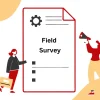
Feedback vs Review: Key Differences & Use Cases
Feedback vs review are often used interchangeably, but they have distinct meanings, purposes, and applications. Understanding these differences can help individuals and businesses effectively use both to foster growth and improvement.
In this article, we’ll explore the key differences between feedback vs review, their significance, and practical scenarios where each is most effective.
What is Feedback?
Feedback is a constructive response or suggestion aimed at improving a specific aspect of performance, behavior, or outcome. It’s often direct, personal, and intended for the recipient to act upon immediately.
Characteristics of Feedback:
- Personalized: Tailored to an individual or specific situation.
- Actionable: Focuses on areas of improvement or reinforcement.
- Timely: Delivered shortly after the event or behavior for maximum relevance.
- Ongoing: Part of a continuous process to guide improvement.
What is a Review?
A review is an evaluative and often public summary of a product, service, or experience. It typically serves to inform others about the quality or suitability of the subject being reviewed.
Characteristics of Reviews:
- Objective: Based on personal experience but directed towards a broader audience.
- Summative: Reflects the overall quality rather than providing granular feedback.
- Public: Often shared on platforms like websites or social media for others to reference.
- Judgmental: Includes ratings, pros, cons, and a final recommendation.
Key Differences: Feedback vs Review
Feedback vs reviews are both vital tools for growth and evaluation, but they serve distinct purposes and are directed at different audiences. Below, we explore the nuances of these concepts under key aspects.
1. Audience
- Feedback: Delivered directly to individuals or teams, feedback is often private. It’s designed to inform and improve the recipient’s performance or outcomes. For example, a manager sharing suggestions with an employee is providing feedback.
- Review: Aimed at the public or potential customers, reviews are typically published online or shared publicly. They provide insights into the quality, reliability, or usability of a product, service, or experience. For instance, a restaurant review on Google is targeted at other diners.
2. Purpose
- Feedback: The primary goal of feedback is improvement. It’s meant to help the recipient identify strengths and weaknesses to refine their skills, processes, or products. For instance, constructive feedback on a presentation might focus on improving delivery or organization.
- Review: Reviews aim to inform and influence others’ decisions. They help prospective users or buyers gauge the value or quality of an offering based on others’ experiences. For example, a product review highlights whether it meets expectations.
3. Tone
- Feedback: Generally constructive and supportive, feedback emphasizes improvement without causing defensiveness. A teacher might provide feedback like, “Your essay is well-structured, but the conclusion could better summarize the main points.”
- Review: Reviews can be evaluative and judgmental. They often reflect the reviewer’s satisfaction or dissatisfaction and can range from praise to criticism. For instance, “The food was delicious, but the service was slow” is a typical review tone.
4. Timeliness
- Feedback: Feedback is most effective when given promptly, whether delivered in real-time or during ongoing processes. A sports coach correcting an athlete’s technique during practice is a timely example.
- Review: Usually retrospective, reviews come after the experience or purchase. They summarize the reviewer’s overall impression, such as a traveler writing about their stay after checking out of a hotel.
5. Scope
- Feedback: Specific and narrow, feedback focuses on particular aspects that need attention. For instance, “Your code works well, but optimizing it will make it more efficient” is focused on a specific area.
- Review: Broad and comprehensive, reviews often cover multiple aspects of an experience, such as price, quality, and customer service. For instance, a car review might discuss performance, comfort, and safety features.
Importance: Feedback vs Reviews
Both feedback vs reviews are pivotal to personal, organizational, and market growth. They foster trust, guide decision-making, and create opportunities for improvement. Let’s delve deeper into their significance.
Importance of Feedback
- Improves Performance Feedback provides actionable insights that enable individuals or teams to refine their skills, strategies, or behavior. Constructive criticism highlights areas for improvement, helping to close performance gaps and build expertise.
- Builds Relationships Open and constructive feedback fosters trust and transparency. When people feel heard and valued, communication becomes more authentic, strengthening workplace or personal relationships.
- Drives Development Feedback acts as a cornerstone for personal and professional growth. It helps individuals and organizations identify learning opportunities, adapt to changes, and achieve long-term goals.
- Enhances Decision-Making Constructive feedback provides clarity and direction, enabling better strategic planning. Organizations can use feedback to align goals with employee or customer needs effectively.
Importance of Reviews
- Guides Decision-Making Reviews act as social proof, helping potential customers make informed decisions about products or services. A series of positive reviews often becomes a deciding factor in consumer purchases.
- Builds Credibility A business with positive reviews earns customer trust and enhances its brand reputation. Authentic testimonials from satisfied customers reinforce the credibility of offerings.
- Provides Market Insights Reviews offer businesses a lens into customer preferences, behaviors, and expectations. They help identify trends, uncover pain points, and refine products or services accordingly.
- Drives Innovation By analyzing customer reviews, businesses can innovate and stay ahead of the competition. Reviews often contain suggestions or ideas that spark new features or products.
Use Cases of Feedback
Feedback is a powerful tool to foster growth, improvement, and connection across various domains. Here are some detailed scenarios where feedback is most effective:
1. Workplace Performance
Feedback in the workplace serves as a vital mechanism to boost productivity, enhance skills, and improve communication.
- For Managers: Constructive feedback helps employees identify areas for improvement. For instance, a manager can offer specific suggestions to refine an employee’s presentation skills or encourage them to adopt more efficient work processes.
- For Teams: Peer-to-peer feedback within teams fosters collaboration and uncovers innovative solutions. Regular performance reviews ensure alignment with organizational goals.
2. Education
In academic settings, feedback drives learning by pinpointing strengths and weaknesses.
- For Students: Teachers provide personalized feedback on assignments or projects to clarify concepts and encourage critical thinking. For example, comments on a student’s essay might focus on improving argument clarity or strengthening evidence.
- For Educators: Feedback from students about teaching methods or course materials helps educators tailor their approach to better meet learning objectives.
3. Customer Service
In business, feedback from customers is invaluable for refining services and products.
- For Product Improvement: Surveys and reviews can reveal what customers love and where there’s room for improvement. For instance, a clothing brand might discover customers are dissatisfied with sizing and adjust their production accordingly.
- For Service Enhancement: Feedback about interactions with support teams helps identify training needs or areas to streamline customer experiences.
Use Cases of Reviews
Reviews are a cornerstone of decision-making in our digital-first world. They serve as social proof, enhance trust, and guide potential customers or audiences. Here’s a closer look at how reviews are used effectively across different domains:
1. E-Commerce: Enhancing Product Credibility
In the bustling world of online shopping, reviews play a critical role. Platforms like Amazon rely heavily on customer feedback to inform buying decisions. When potential buyers see detailed reviews, complete with pros and cons from real users, it helps them feel confident in their choices.
2. Travel and Hospitality: Building Trust in Experiences
Travelers frequently turn to platforms like TripAdvisor or Google Reviews before booking hotels, restaurants, or attractions. A well-documented review with vivid descriptions and photos provides reassurance and sets realistic expectations.
3. Entertainment: Shaping Public Perception
Whether it’s a movie, a book, or a video game, reviews influence audience turnout and sales. Platforms like Rotten Tomatoes or Goodreads aggregate user feedback and professional critiques to help consumers decide how to spend their time and money.
Positive reviews can create hype, while constructive criticism helps creators understand audience preferences.
4. Healthcare: Trust in Medical Services
Patient reviews on platforms like Healthgrades or Zocdoc provide critical insights into the quality of care. They help patients choose doctors, hospitals, or wellness centers based on experiences shared by others. A highly rated healthcare professional often attracts more patients and builds a reputation for excellence.
How to use Feedback & Reviews Effectively?
For Individuals:
- Act on Feedback: Treat feedback as a growth opportunity, not criticism.
- Seek Feedback: Regularly ask for constructive input from peers or mentors.
For Businesses:
- Encourage Reviews: Create platforms where customers can share their experiences.
- Analyze Trends: Use reviews and feedback to identify improvement areas.
- Engage with Reviewers: Respond to both positive and negative reviews to build trust.
Conclusion
While feedback vs reviews may seem similar, they serve unique purposes. Feedback vs. Review isn’t a matter of choosing one over the other; it’s about understanding when and how to use each. Feedback fosters personal and professional growth, while reviews shape public perception and guide decisions.
By leveraging both strategically, individuals and organizations can unlock immense value and drive continuous improvement.
Frequently Asked Questions? (FAQs)
Can Feedback Be Anonymous?
Yes, feedback can be anonymous, especially in surveys or online forms, to encourage honesty.
What Is The Main Difference Between Feedback vs Review?
Feedback is direct, specific, and aimed at improvement, while a review is public, general, and evaluative.
Why Are Reviews Important For Businesses?
Reviews influence purchasing decisions, enhance credibility, and provide valuable customer insights.
How Can Feedback Improve Workplace Performance?
Feedback identifies strengths and weaknesses, helping employees refine their skills and align with organizational goals.
Are Reviews Always Objective?
Not necessarily. Reviews are often subjective and influenced by personal experiences and emotions.
Enhance Patient Care and NABH Compliance with LazyMonkey
LazyMonkey is your all-in-one solution for improving patient care, retaining more patients, and meeting NABH standards. Our powerful QR-based feedback tool enables you to capture real-time insights from patient feedback, discharge surveys, staff and doctor evaluations, and clinical research, while also streamlining inter-departmental communication.
Transform your healthcare facility today - reach out to us at hello@lazymonkey.in, or request a demo here!
Elevate Your Restaurant Experience with LazyMonkey
LazyMonkey’s QR-based feedback system helps you gather real-time insights from customers, track satisfaction levels, and enhance the dining experience. Get instant feedback on your menu, service, and ambience, and make data-driven improvements to boost repeat customers and reviews.
Improve your restaurant today – reach out to us at hello@lazymonkey.in, or request a demo here!
Empower Student Engagement and Campus Improvement with LazyMonkey
LazyMonkey offers a seamless way to gather student feedback, track satisfaction, and enhance campus life. From course evaluations to dorm feedback, our QR-based solution makes it easy to capture valuable insights and improve student retention.
Upgrade your university experience – contact us at hello@lazymonkey.in, or request a demo here!
Streamline Feedback and Drive Performance Across Your Enterprise/Franchise with LazyMonkey
Whether you manage one or multiple locations, LazyMonkey’s QR-based feedback system helps you gather real-time employee and customer feedback. Improve operational efficiency, track satisfaction, and make data-driven decisions to enhance brand consistency and growth.
Transform your franchise today – reach out to us at hello@lazymonkey.in, or request a demo here!
Enhance Customer Satisfaction and Service Standards in Banking with LazyMonkey
LazyMonkey empowers banks to capture real-time feedback from clients across branches. Improve customer experience, assess service quality, and ensure regulatory compliance with our QR-based solution, helping you retain clients and meet banking standards.
Elevate your bank’s customer care – contact us at hello@lazymonkey.in, or request a demo here!
Boost Customer Engagement and Mall Satisfaction with LazyMonkey
LazyMonkey’s QR-based feedback tool enables you to collect feedback from shoppers, track satisfaction, and enhance the mall experience. Gather insights on store services, cleanliness, and entertainment to create an unmatched customer journey.














